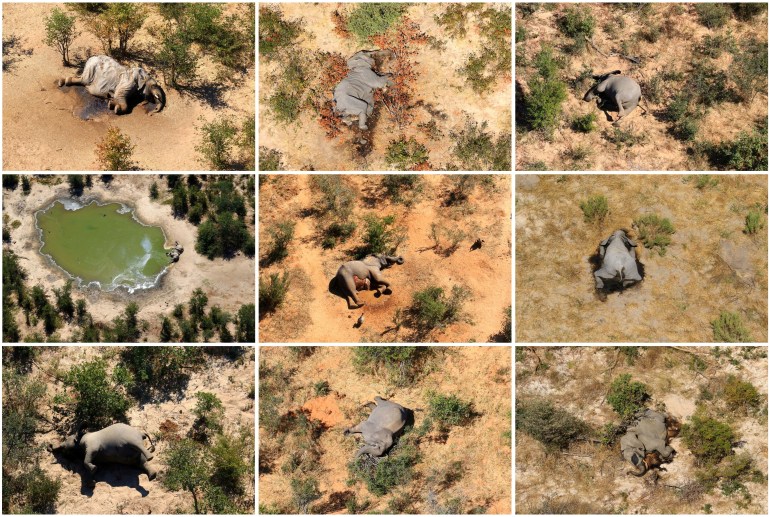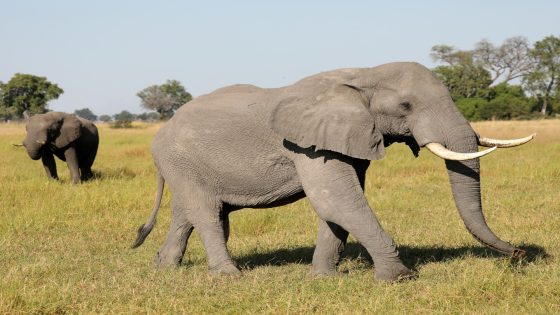An investigation into the sudden deaths of at least 350 elephants in Botswana in 2020 has revealed the cause was almost certainly a “toxic brew” of open water tainted by a species of cyanobacteria that released cyanotoxins, essentially contaminating the elephants’ watering holes.
According to researchers, approximately 20 watering holes in Botswana’s Okavango Delta had been contaminated across roughly 6,000sq km (2,316 square miles).
So what happened, and how?
What is cyanobacteria and how does it harm elephants?
Although not all cyanobacteria, commonly referred to as blue-green algae, is toxic, some cyanobacteria can produce a type of deadly algal blooms (HABs) in standing water. This is the type which was discovered in the investigation carried out by researchers at King’s College London.
The study showed that the African elephants (Loxodonta africana) died in May and June 2020 after drinking from water holes contaminated with these toxic algal blooms.
“Scientists believe that the production of cyanotoxins is related to certain environmental triggers, for example, sudden rise in water temperature, nutrient loading, salinity,” Davide Lomeo, Earth observation scientist at King’s College London, a collaborator with Plymouth Marine Laboratory and the Natural History Museum in London, and lead researcher in the recent study, told Al Jazeera.
How did the elephant deaths come to light?
In early to mid-2020, a series of routine aerial surveys conducted by helicopter by the conservation organisation, Elephants Without Borders, revealed multiple elephant carcasses scattered across the landscape of the Ngamiland district of northern Botswana.
The aerial survey showed 161 elephant carcasses and 222 sets of bones, while also counting 2,682 live elephants throughout the eastern region of the Okavango Panhandle. In addition, the distance between the dead elephants indicated the deaths had been sudden, rather than gradual.
“The strong clustering of carcasses also suggests that the event was sudden, with limited dispersal of elephants prior to death,” the authors of the study said.

How did researchers identify toxic algae as the cause of death?
Before researchers confirmed it was toxic algae which killed the elephants, they had to rule out several other probable causes.
“Although this area is a known poaching hotspot in Botswana, this was ruled out since elephant carcasses were found with tusks intact,” the authors of the study said.
Other initial theories included virulent and bacterial causes, such as encephalomyocarditis virus or anthrax, but the evidence taken from the field – such as the age of the dead elephants and the absence of any clinical signs of disease, meant the researchers ruled these out as the cause.
The distribution of carcasses and bones suggested a unique “spatial pattern”, which indicated that localised factors may have played a role in the mass die-off. This led to further exploration of specific environmental and ecological conditions in the affected areas.
There were several other factors that served as evidence that the elephant watering holes were to blame. Using satellite photos, researchers measured the distance the elephants walked after they drank from the watering holes – an average of 16.5km (10.2 miles). Many of the elephants died shortly thereafter, roughly 3.6 days (88 hours), after they drank from the nearby contaminated water holes.
The report states that 88 hours aligned with previously reported toxicological timelines for other large mammals which have died from blue algal poisoning.
In addition, Lomeo’s previous body of doctoral work investigating the history of mass-mortality events and water quality in waterbodies in Africa served as evidence to further look into the theory of water hole contamination.
“This event was what led to this idea, since it was a well-covered news at the time, but no one really knew why they died. I then applied my skills in geospatial and computational data science to investigate the event under a well-known set of methods typically applied in epidemiological investigations (eg COVID-19),” explained Lomeo.

What is still unknown about the elephant deaths?
It is impossible to measure the level of toxicity for each waterhole from aerial photos. In addition, it is unclear whether elephants drank from one watering hole or several, according to researchers.
“It is highly likely that they drank from multiple pans before their death. It cannot be established if the fatal intoxication occurred in a single drinking event, but it seems more plausible that if cyanotoxins were present and were the cause of the die-off, this was through toxins bioaccumulation in elephants’ organs,” stated the study.
Although it is clear that the toxic waterholes were the likely source of the elephants’ mass mortality, there remains some uncertainty about the findings due to the timing of the mass die-off.
“The event occurred during the COVID-19 movement restrictions, and timely intervention was not possible. Therefore, tissue samples [which would have confirmed the presence/ absence of cyanotoxins] were not collected. Post-mortem investigations also need to be done within a certain timeframe, beyond which samples would be too degraded. Additionally, cyanotoxins cannot be detected from satellites, so the links can only be but indirect,” Lomeo explained.
As the aerial data was collected considerable time after the deaths in March and May 2020 – researchers could not definitively rule out the involvement of other animals in the elephant deaths.
Furthermore, smaller creatures may have been missed in the aerial survey, potentially limiting scientists’ understanding of the full scope of the incident.
“The area is well-known for very high predation rates, meaning that animal carcasses disappear quickly because of scavengers like hyenas and vultures. Hence, the involvement of other animals cannot be ruled out,” Lomeo said.
The specific conditions that would produce the level of toxicity in a watering hole that would be lethal to surrounding animal species are also still unknown.
“There is still uncertainty. We know that certain cyanobacteria species are more likely to produce cyanotoxins, and we know which toxins each species typically produces,” said Lomeo.
According to the research, cyanotoxins exhibit significant variations in their potency and effects. Certain types are extremely toxic, capable of causing death even in very small concentrations. Others, while less immediately dangerous, may still pose health risks at higher levels without necessarily being lethal. The field of cyanotoxin research remains active, with many aspects yet to be fully understood and explored.
Despite this, the overall findings of the study have been widely accepted. “The cause of the die-off has been officially attributed by the Government of Botswana to environmental intoxication by cyanobacterial toxins, also known as cyanotoxins,” the study’s authors said.
Could this happen again?
Although mass deaths of elephants are rare, researchers cannot be certain it will not happen again and that it will only affect elephants or land animals.
“[In] all arid systems where animals are dependent on stagnant water in lakes/ponds are susceptible to this [mass die-offs], the aquatic life in lakes also can be harmed in this same manner. We have even seen this in rivers and oceans where high nitrification from agricultural run-off combined with warming temperatures leads to disastrous bacterial blooms,” George Wittemyer, a behavioural ecologist at Colorado State University, one of the institutes involved in a study in Kenya that revealed that elephants use individual names, told Al Jazeera.
While it was relatively easy for researchers to identify the elephant carcasses from the air due to their size, the sudden deaths of smaller animals might not be so easy to identify.





